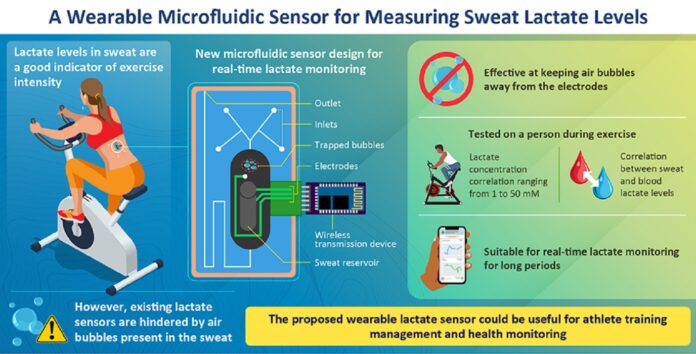Wearable microfluidic sensors have the ability to measure lactate concentration in sweat, which can be used to gauge exercise intensity. However, air bubbles in sweat might obstruct the measurement, making it difficult. A Japanese study created a wearable sensor for continuously detecting sweat lactate during exercise, including a bubble-trapping zone in its microfluidic technology. This technology can help athletes manage their training and wellness.
Human sweat contains:
- a wealth of health information,
- revealing a person’s hydration level,
- electrolyte balance, and
- overall physiological state.
Lactate levels in sweat are a helpful biomarker of exercise intensity, assisting in estimating lactic acid in the blood and predicting muscle weariness. Wearable sensors for continuously monitoring biomarkers such as sweat lactate have been created. However, their microfluidic channels frequently trap air bubbles present in sweat.
Wearable sensors provide continuous monitoring of indicators such as sweat lactate. Using cutting-edge microfluidics technology, scientists created devices that transport minute amounts of sweat to small chemical sensors, which can wirelessly broadcast their measurements in real-time.
To address this problem, a team led by Associate Professor Isao Shitanda of Tokyo University of Science (TUS) created a unique microfluidic sweat lactate sensor unaffected by air bubbles.
A typical lactate oxidase sensor is mounted via double-sided tape to a silicone polymer microfluidic system in the proposed wearable device. Sweat enters the microfluidic channels through four inlets and flows towards a reservoir near the electrodes as the person perspires. As new work enters, old work exits the system through an outlet, and a small wireless transmitter reports the measured lactate levels.
The proposed design’s primary novelty was employing a larger-than-usual sweat reservoir, which created a gap of around four microliters for catching air bubbles that infiltrated the device. The sensor was tested in the lab to ensure that the bubble-trapping zone operated as anticipated and that the sweat flow rate did not impact the measurements. The sensor detected a link between sweat and blood lactate levels and a lactate concentration correlation ranging from 1 to 50 mM.
Overall, the findings of this study suggest that wearable microfluidic sensors can monitor sweat biomarkers during exercise.
Dr. Shitanda said, “Because the proposed lactate sensor’s microfluidic system is made of a soft, flexible, and non-irritating material, it could be used to continuously monitor lactate levels in sweat, particularly in sports and medicine; wearable lactate sensors may become useful condition management tools in sports such as football and basketball, allowing team managers to know when it’s best to replace a player.”
Only as wearable sensors improve capability and reliability will the future of training management and healthcare monitoring be revealed.
The conclusion shows that A lactate sensor with microfluidic technology was created to continuously monitor sweat lactate levels, overcoming instability difficulties caused by air bubbles in the channel. To prevent electrode contact, a reservoir was established.
Journal Reference:
- Isao Shitanda, Yuro Ozone, etal. Air-Bubble-Insensitive Microfluidic Lactate Biosensor for Continuous Monitoring of Lactate in Sweat. ACS Sensors. DOI: 10.1021/acssensors.3c00490
